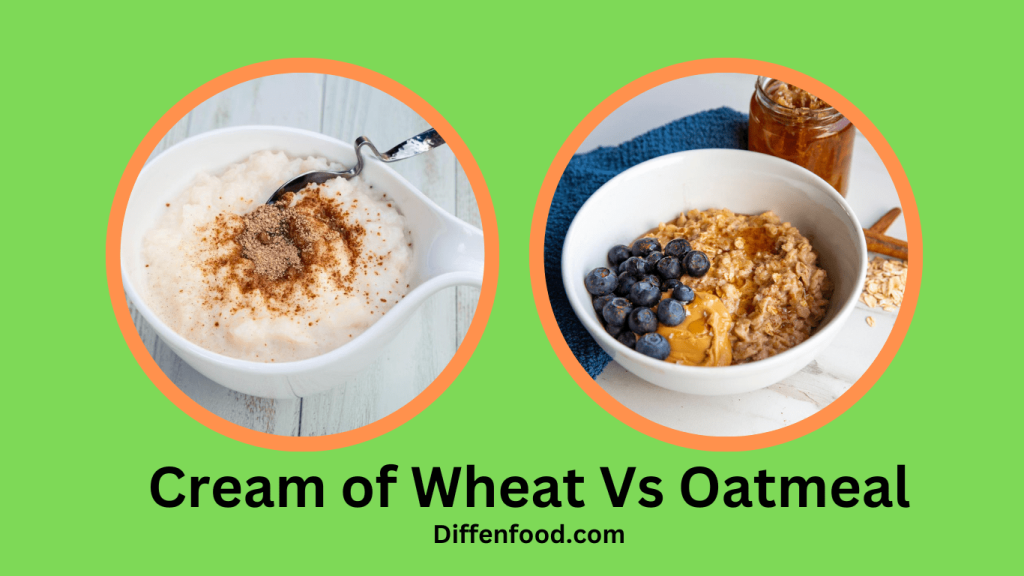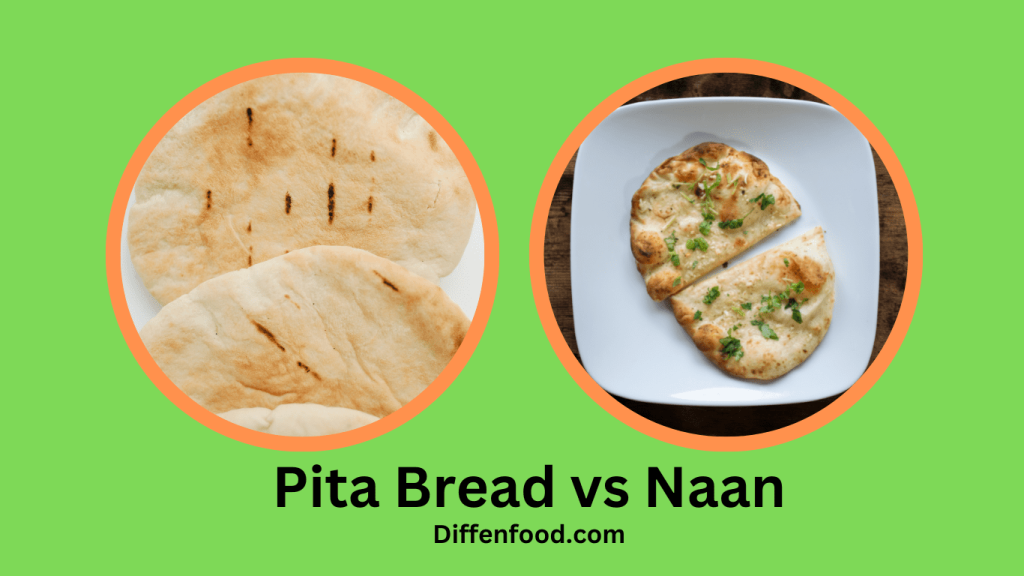
” Cream of wheat vs oatmeal ” is a classic breakfast showdown that has been debated for decades. Cream of wheat is a hot cereal made from wheat semolina. Oatmeal is made from oats. Both are popular options for breakfast due to their high nutritional value and easy preparation.
However, the debate over which one is better for health and taste is ongoing. This article aims to provide a professional comparison between the two, highlighting their differences and similarities, and ultimately helping you make an informed decision about which one to choose.
Know what they are

Cream of Wheat
Cream of Wheat is a hot breakfast cereal made from ground wheat semolina. It is a smooth and creamy texture that is often served with added sugar, butter, and milk. Cream of Wheat is a popular breakfast option because it is easy to prepare and provides a good source of carbohydrates and fiber. It can also be used as a base for savory dishes like soups and stews.
Oatmeal
Oatmeal is a type of porridge made from oats that have been boiled in water or milk. It is a popular breakfast food that is high in fiber and protein, making it a healthy meal option. Oatmeal can be flavored with various ingredients such as fruits, nuts, and spices. It is also commonly used as an ingredient in baking recipes for cookies, bread, and granola bars.
Origin: Cream of Wheat Vs Oatmeal

Cream of Wheat, a popular breakfast food in the United States, was first introduced in 1893. It was invented by a man named Tomlinson, a miller from Grand Forks, North Dakota. The product was initially called “farina” and was marketed as a healthier alternative to oatmeal. However, it did not become popular until the company changed the name to “Cream of Wheat” in 1898 and began an aggressive marketing campaign. The product’s success was largely due to its convenience and ease of preparation, as well as its smooth and creamy texture.
Oatmeal has been around for centuries and has been a staple food in many cultures. It is made from ground oats and is a nutritious and filling breakfast option. The earliest evidence of oatmeal consumption dates back to ancient Rome, where it was consumed as a porridge-like dish. In Scotland, oatmeal was a traditional food, and it was used to make porridge, oatcakes, and bannocks. Oatmeal became popular in the United States in the late 19th century, and it was marketed as a health food due to its high fiber content.
Nutritional Differences: Cream of wheat vs oatmeal

When it comes to breakfast cereals, cream of wheat and oatmeal are two popular choices. While both are hot cereal options that can be served with a variety of toppings, they differ significantly in terms of nutritional content.
Calories and Macronutrients
Cream of wheat is a low-calorie option, with one serving (28 grams) containing around 80 calories. In contrast, oatmeal is slightly more calorie-dense, with one serving (28 grams) providing around 120 calories. However, oatmeal is also higher in protein, with approximately 4 grams per serving, compared to the 2 grams found in cream of wheat. Oatmeal also contains healthy fats, including omega-3 fatty acids, which are important for heart health.
Vitamins and Minerals
Both cream of wheat and oatmeal are fortified with vitamins and minerals, but oatmeal tends to have more of these essential nutrients. For example, one serving of oatmeal contains around 10% of the daily recommended intake of iron, compared to just 2% in cream of wheat. Oatmeal is also a good source of magnesium, which is important for bone health, while cream of wheat contains very little of this mineral.
Fiber Content
One of the key differences between cream of wheat and oatmeal is their fiber content. Oatmeal is a good source of dietary fiber, with one serving containing around 3 grams. This fiber can help to lower cholesterol levels and improve digestive health. In contrast, cream of wheat is low in fiber, with less than 1 gram per serving. While some brands do offer versions that are higher in fiber, overall, oatmeal is the better choice if you’re looking to increase your fiber intake.
Both cream of wheat and oatmeal are good breakfast options, they differ significantly in terms of nutritional content. Oatmeal is generally the healthier choice, as it’s higher in protein, fiber, and essential vitamins and minerals. However, cream of wheat can be a good option for those who are looking for a lower-calorie breakfast cereal.
Processing and Digestibility: Cream of wheat vs oatmeal

There are significant differences in Cream of Wheat and oatmeal’s processing and digestibility. The primary difference between the two is that Cream of Wheat is made by milling wheat berries, while oatmeal is made from rolled or steel-cut oats. Cream of Wheat is also processed more than oatmeal, as it undergoes a refining process that removes the bran and germ.
The difference in processing between Cream of Wheat and oatmeal has an impact on their digestibility. Oatmeal contains soluble fiber, which slows down the digestion process and promotes feelings of fullness. In contrast, Cream of Wheat lacks fiber and is quickly digested, leading to a spike in blood sugar levels. This difference in digestibility can impact someone’s energy levels throughout the day.
Another factor to consider when comparing Cream of Wheat and oatmeal is their impact on glycemic index (GI). GI measures how quickly carbohydrates in food are converted to glucose and released into the bloodstream. Foods with a high GI can cause blood sugar spikes and crashes.Oatmeal has a lower GI than Cream of Wheat due to its higher fiber content. This means that oatmeal can provide sustained energy, while Cream of Wheat may lead to a sugar crash.
Oatmeal is often considered the better option for weight loss. Because its high fiber content. Fiber helps promote feelings of fullness, reducing the likelihood of overeating.Additionally, oatmeal is lower in calories and fat compared to Cream of Wheat.
Texture and Flavor: Cream of wheat vs oatmeal

Texture
When it comes to texture, Cream of Wheat has a smoother consistency compared to oatmeal. This is because Cream of Wheat is made from wheat semolina that is finely ground into a powder, whereas oatmeal is made from whole oats that have been rolled or cut. As a result, oatmeal has a grainier texture that some people may find more satisfying.
Flavor
In terms of flavor, Cream of Wheat has a mild taste that can be described as slightly sweet and nutty. On the other hand, oatmeal has a nuttier and earthier flavor that some people may find more robust. One of the main differences in flavor between the two cereals is the type of grain used. While Cream of Wheat is made from wheat, oatmeal is made from oats, which gives it a distinct flavor profile.
Versatility
Another key difference between Cream of Wheat and oatmeal is the versatility in flavor options. Both cereals can be prepared with a variety of ingredients, such as fruits, nuts, and spices, to enhance their taste. However, oatmeal has a wider range of flavor options because the oats can be flavored with different spices, such as cinnamon, nutmeg, and ginger, to create a variety of delicious combinations. Cream of Wheat, on the other hand, is often served plain or with simple toppings like butter and sugar.
Although Cream of Wheat and oatmeal are both hot cereals, there are clear differences in texture and flavor. Cream of Wheat has a smoother texture and milder flavor, while oatmeal has a grainier texture and nuttier flavor. Both cereals can be enjoyed with a variety of flavor options, but oatmeal has a wider range due to the versatility of oats. Ultimately, the choice between the two cereals comes down to personal preference and taste.
Cooking and Preparation: Cream of wheat vs oatmeal

Cream of Wheat and oatmeal differ in their cooking and preparation methods. One of the main differences is the cooking time. Cream of Wheat cooks much faster than oatmeal, which can take up to 20 minutes to cook. This is because Cream of Wheat is made from semolina, a type of wheat flour that has been ground into small granules. On the other hand, oatmeal is made from whole or rolled oats, which take longer to cook.
Another difference between Cream of Wheat and oatmeal is the preparation method. Cream of Wheat is typically cooked on the stove with milk or water, while oatmeal can be cooked on the stove, in the microwave, or even overnight in the fridge. Oatmeal also has a variety of different types, including steel-cut oats, rolled oats, and instant oats, each with their own unique cooking instructions.
While Cream of Wheat and oatmeal are different, they can be interchangeable in some recipes. For example, both can be used in baked goods such as muffins or pancakes. However, it’s important to note that the texture and flavor may differ depending on which one is used. Cream of Wheat tends to have a smoother texture and a slightly nutty flavor, while oatmeal has a more chewy texture and a nuttier taste.
Conclusion
In conclusion, the comparison between cream of wheat vs oatmeal has revealed that both cereals have their unique nutritional values and personal preferences. While oatmeal is high in fiber and protein, cream of wheat is rich in iron and calcium. The decision of which breakfast cereal to choose ultimately comes down to individual preferences and nutritional needs. For those who prioritize a high fiber intake, oatmeal is the better option, while those who are looking to supplement their iron and calcium intake may prefer cream of wheat.
However, regardless of personal preference, both cereals offer a wholesome and nutritious breakfast option. Therefore, we recommend switching between cream of wheat and oatmeal to reap the benefits of both cereals and add variety to your breakfast routine.


